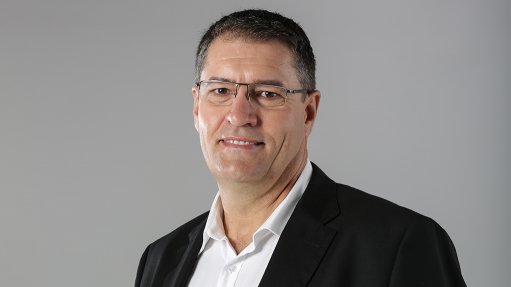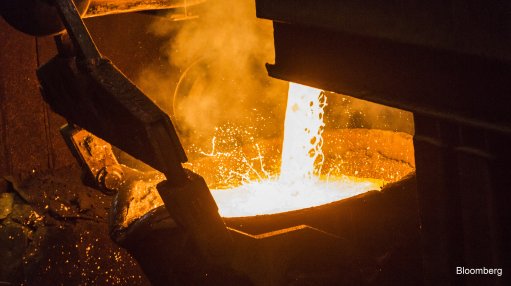AngloGold in mass meetings with workers ahead of wage talks

AngloGold Ashanti CEO Srinivasan (Venkat) Venkatakrishnan tells Mining Weekly Online’s Martin Creamer of the company’s eight days of mass meetings with its mineworkers ahead of the crucial upcoming wage talks in the gold-mining industry.
JOHANNESBURG (miningweekly.com) – Gold major AngloGold Ashanti on Monday outlined how it had conducted eight days of mass meetings with unlimited question-and-answer sessions with all of its mineworkers, ahead of the crucial gold industry wage talks.
With support of organised labour, the company had conducted the mass meetings across every one of its South African sites, AngloGold Ashanti CEO Srinivasan (Venkat) Venkatakrishnan told Creamer Media’s Mining Weekly Online during a media roundtable ahead of the company’s results presentation, which saw the company notch up a second consecutive year of production growth, plus a 13% reduction of all-in sustaining costs (AISC).
The CEO personally addressed and took full part in the mass meetings, together with COO Mike O’Hare and individual mine general management, bringing news of success in completely converting hostel accommodation and taking action on garnishee orders, which were areas of mineworker concern.
“Importantly, what we did was open up unlimited time for questions and answers and the feedback we’ve had has been quite encouraging,” Venkat said in response to Creamer Media’s Mining Weekly Online.
The company has acceded to employee requests that these mass meetings take place every year.
They were held against the background of several gold mining companies initiating Section 189 retrenchment consultation processes, with the National Union of Mineworkers (NUM) general secretary Frans Baleni predicting a potential “bloodbath of job losses” as a result, and recruitment company Teba CEO Graham Herbert warning of a perception doing the rounds that platinum mineworkers were in a sweeter spot than their gold-mining colleagues as a result of their five-month strike.
On steps to consolidate its South African footprint from five underground mines and two surface operations into three entities to capture operating, service and infrastructural synergies of neighbouring units, Venkat told Creamer Media’s Mining Weekly Online that the underground Savuka mine had been successfully integrated with the Tau Tona mine and Great Noligwa into Moab, with Vaal River the next focus.
“We’ll probably take longer with West Wits, given the challenges we currently face there on the safety front at Mponeng. That we will have to monitor as time goes by, but we’re making progress,” he added.
In response to JP Morgan gold analyst Allan Cooke on the representation of the Association of Mineworkers and Construction Union (AMCU) at AngloGold Ashanti’s mines, O’Hare said NUM remained the dominant union with AMCU in second position but dominating by a large percentage the company’s West Wits operations and NUM similarly dominating Vaal River.
O’Hare said the gold CEOs were working together with the Chamber of Mines to develop a strategy and the tactics ahead of the wage negotiations.
“It’s our employees who decide whether to strike and how long that strike will be and those are the people we need to influence.
“Venkat has held mass meetings across all of our operations and with some frank talk. Our employees get information from more than one source and the engagement processes that the rest of us are following are to give our employees a sense of what’s real,” O’Hare added.
Meanwhile, eight quarters of increased gold production culminated in an 8% greater output in the 12 months to December 31, which Venkat described as “a very good production performance”.
In 24 months, the company has slashed two-thirds off overhead expenditure and brought in two low-cost mines, selling some assets, closing others and removing lossmaking ounces from ongoing operations.
The ten-jurisdiction gold-mining company reported 4.44-million ounces of production at AISC of $1 026/oz, which unlocked free cash flow of $142-million on cash costs of $787/oz.
Output was up from the 4.1-million ounces at $1 174/oz in 2013 - with the result matching guidance, almost exactly in the case of AISC, which is a measure that captures direct operating costs, corporate and exploration expenditure and capital investment required to sustain the business.
Capital expenditure (capex) of $1.2-billion was 39% below that of 2013 and corporate and year-on-year corporate costs 54% down at $92-million.
Exploration costs were 44% lower at $144-million and earnings stable at $1 665-million, despite a 10% drop in the gold price for the period.
"The second year of growth is gratifying but the real focus for us is on improving margins. Regardless of the gold price, we won't relax the pressure on costs or hesitate to take out marginal production if needed," Venkat commented.
AISC for 2014 were 18% lower than in 2012, while production was up 12% over the same period as Kibali and Tropicana have ramped up output.
Despite a 10% drop in the average gold price, the company's adjusted earnings before interest, taxes, depreciation and amortisation remained steady at $1.67-billion, while free cash flow – excluding once-off retrenchment costs in Ghana and the Rand Refinery loan – improved to $142-million compared with an outflow of $1.06-billion the previous year.
The improved operational performance was achieved along with a record safety performance, with the fewest number of workplace fatalities.
Mining in Africa, outside of South Africa, was fatality free for the first time ever.
AngloGold Ashanti is pursuing a range of measures to generate cash from internal sources to reduce debt by about $1-billion over the medium term.
The steps include pursuing additional savings from current operations, realising synergies from combining neighbouring mines and infrastructure in South Africa and potentially introducing partners in key areas, most notably projects in Colombia and in one of its operating assets.
Underground production has ceased at the Obuasi mine in Ghana, where the focus is now on the feasibility study – which is being reviewed by SRK – into the redevelopment of the high-grade orebody as a fully mechanised operation.
The study is nearing completion, following which it will be optimised, while discussions with the government and potential funding and operating partners will be held.
AngloGold Ashanti recorded strong operating results in the fourth quarter, when production of 1.156-million ounces was 2.5% better than the previous quarter and better than guidance.
Total cash costs of $724/oz were 12% better than the preceding quarter, which averaged $820/oz, and well ahead of guidance.
Production guidance for the first quarter of 2015 is estimated to be between 900 000 oz to 940 000 oz at total cash costs of $830/oz to $860/oz, assuming average exchange rates against the dollar of 11.60 (Rand), 2.60 (Brazil Real), 0.85 (Australian dollar) and 9.50 (Argentina Peso), with oil at $70/bl.
This guidance takes into account the slow seasonal ramp-up in production following the Christmas break, ongoing power disruptions and also interruptions to normal operations related to safety-related stoppages, all in South Africa.
Full-year production guidance for the year is now between 4-million ounces to 4.3-million ounces, reflecting the sale of the Navachab mine, reduction in production from Mali, cessation of underground production at Obuasi, only partially offset by the expected first-quarter production ramp-up from Cripple Creek & Victor.
Total cash costs are now anticipated to be $770/oz to $820/oz, which factors in the average exchange rates against the dollar of 11.60 (Rand), 2.60 (Brazil Real), 0.85 (Australian dollar) and 9.50 (Argentina Peso), with oil at $70/bl.
AISC are forecast at $1 000/oz to $1 050/oz.
Capex for the full year is expected to be $1-billion to $1.1-billion.
Comments
Press Office
Announcements
What's On
Subscribe to improve your user experience...
Option 1 (equivalent of R125 a month):
Receive a weekly copy of Creamer Media's Engineering News & Mining Weekly magazine
(print copy for those in South Africa and e-magazine for those outside of South Africa)
Receive daily email newsletters
Access to full search results
Access archive of magazine back copies
Access to Projects in Progress
Access to ONE Research Report of your choice in PDF format
Option 2 (equivalent of R375 a month):
All benefits from Option 1
PLUS
Access to Creamer Media's Research Channel Africa for ALL Research Reports, in PDF format, on various industrial and mining sectors
including Electricity; Water; Energy Transition; Hydrogen; Roads, Rail and Ports; Coal; Gold; Platinum; Battery Metals; etc.
Already a subscriber?
Forgotten your password?
Receive weekly copy of Creamer Media's Engineering News & Mining Weekly magazine (print copy for those in South Africa and e-magazine for those outside of South Africa)
➕
Recieve daily email newsletters
➕
Access to full search results
➕
Access archive of magazine back copies
➕
Access to Projects in Progress
➕
Access to ONE Research Report of your choice in PDF format
RESEARCH CHANNEL AFRICA
R4500 (equivalent of R375 a month)
SUBSCRIBEAll benefits from Option 1
➕
Access to Creamer Media's Research Channel Africa for ALL Research Reports on various industrial and mining sectors, in PDF format, including on:
Electricity
➕
Water
➕
Energy Transition
➕
Hydrogen
➕
Roads, Rail and Ports
➕
Coal
➕
Gold
➕
Platinum
➕
Battery Metals
➕
etc.
Receive all benefits from Option 1 or Option 2 delivered to numerous people at your company
➕
Multiple User names and Passwords for simultaneous log-ins
➕
Intranet integration access to all in your organisation



















